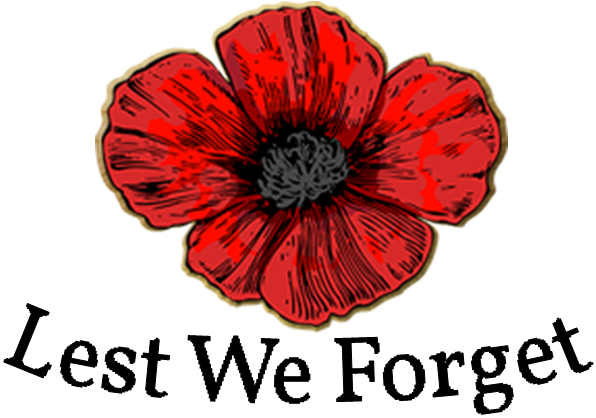Victorian Association of Jewish Ex & Servicemen & Women Australia Incorporated
Founding Member General Sir John Monash GCMG KCB VD


Wreath Laying Protocols From Ceremonial Manual Vol 1, Chapter 21
by Judy Landau
(Past President & Life Member)
“Subject to prior consultation and agreement, and assuming that all those listed are participating, the following sequence is recommended for assembly at the local War Memorial for wreath-laying. It is also assumed that the Lord Lieutenant or his representative is not present otherwise he would take precedence as the Sovereign's representative.”
Ceremonial Manual Volume 1, Chapter 21
21.16 Wreaths of Poppies
An early use of the poppy on Anzac Day was in 1940 in Palestine, where it grows in profusion in the spring. At the Dawn Service each soldier dropped a poppy as he filed past the Stone of Remembrance. A senior Australian officer also a laid a wreath of poppies that had been picked from the hillside of Mt Scopus.
Order of Precedence
Assuming that a member of the Royal Family is not present, the following simplified Table of Precedence would normally apply for those attending a Service. The only person whose precedence at Remembrance services is absolute is Her Majesty the Queen. The precedence of all others, despite what appears in the published Table of
Precedence, may vary from time to time depending on local traditions, the relationship between host and guests, and the requirements of courtesy and hospitality.
Normally, an acceptable compromise can be reached provided there is adequate consultation beforehand. It is most important to avoid embarrassment. Assuming that all those listed are participating and that the Governor-General or his representative is not present (otherwise he would take precedence as the Sovereign’s representative) and subject to prior consultation and agreement the following sequence is recommended for assembly at a local War Memorial for a Remembrance service:

1. The Governor-General
2. The Governor of the State
3. The Prime Minister of Australia
4. The Premier of the State
5. The President of the Senate and the Speaker of the House of Representatives according to the date of appointment; if they are appointed at the same time, the President shall have precedence.
6. The Chief Justice of Australia
7. a) Ambassadors and High Commissioners according to the date of presentation of their letters of Credence or Commission, or, in the case of High Commissioners who do not present letters of Commission, according to the date of arrival in Canberra
b) Charges d’Affaires en pied or en titre according to the date of the presentation of their letters of Credence
c) Charges d’Affaires and Acting High Commissioners according to the date of assumption of duties
8. Members of the Federal Executive under summons
9. The Leader of the Federal Opposition
10. The Lord Mayor within his/her city
11. Justices of the High Court according to seniority
12. a) The Chief Judge of the Federal Court of Australia
b) The President of the Australian Conciliation and Arbitration Commission
13. The Chief Justice of the State and, after him other Chief Justices according to seniority
14. Privy Counsellors
15. The Chief of Defence Force
16. Members of the Parliament of the Commonwealth
17. The Chairman of the Council of the Australian War Memorial and the National President of the Returned and Services League of Australia
18. The Chief of Navy
19. The Chief of Army
20. The Chief of Air Force
21. The National President of the Australian Veterans’ and Defence Services Council
22. The National President of the Naval Association of Australia
23. The National President of the Australian Flying Corps and the Royal Australian Air Force Association
24. The National President of the War Widows’ Guild of Australia
25. The National President of the Australian Federation of Totally and Permanently Incapacitated Ex-Servicemen and Women
26. The Chairman of the Legacy National Coordinating Council, accompanied by two Junior Legatees
27. Members of the Diplomatic Corps
28. Heads of religious communities
29. Members of the State Executive Council under summons to the council
30. Leader of the Opposition
31. Judges of the State according to seniority
32. The Secretaries of Departments of the Australian Public Service and their peers and the Chiefs of the Australian Naval, General, and Air Staffs, according to the date of first appointment to an office within this group
33. Consuls-General, Consuls and Vice-Consuls according to the date on which their recognition was granted
34. Recipients of decorations and honours taking precedence over Knights Bachelor and Knights of various Orders (including Knights Bachelor), all according to precedence promulgated in the Commonwealth of Australia Gazette Monday 17 June 1996
35. The Chief of Police
36. Civic VIPs
37. Representatives of regular forces
38. Representatives of reserve forces
39. Representatives of ex-Service associations
40. Representatives of uniformed public services (Police, Fire Brigade, Ambulance services)
41. Representatives of uniformed voluntary services (St John Ambulance, Red Cross, etc)
42. Representatives of cadet forces
43. Representatives of youth organisations
44. Members of the public.
The suggested procedure for laying a wreath is to:
Approach the memorial with the wreath in your right hand - halt, pause and lay the wreath. Continue as follows:
- For people with no medals of their own: straighten up (hands by sides), step back a pace, pause and move away
- For service personnel in uniform: salute, pause and move away
- For people wearing their own medals with no uniform: cover medals with right hand, pause, hands by sides and move away
![]()


Bugle Calls
compiled by Judy Landau
(Past President & Life Member)
Everyone knows about the Last Post and Reveille, right? You may be surprised to learn that these two bugle calls hardly even scratch the surface of the numerous calls that were sounded, and usually it is not Reveille (unless the bugler is Navy) that is sounded after Last Post at ceremonies, but Rouse. There is plenty of misinformation circulating on the internet on this topic, so let’s try to set the record straight.
Bugle calls are brief tunes that originated as military signals on ships or on the battle field. It was the primary way of communication to give the Commander’s orders, as the bugle could be heard over the noise of the battlefield. Mounted infantry knew what to do when the Cease Fire was sounded, or Gallop, Trot, Go Forward and so on. The list below is about half of some British Commonwealth and American bugle calls that were used in camp and quarters:
- Adjutant’s Call: indicates that the adjutant is about to form the guard, battalion, or regiment.
- Alarm: For troops to turn out under Arms.
- Assembly: Signals troops to assemble at a designated place.
- Attention: Sounded as a warning that troops are about to be called to attention.
- Boots and Saddles: Sounded for mounted troops to mount and take their place in line.
- Call to Quarters: Signals all personnel not authorised to be absent, to return to their quarters for the night.
- Charge: Signal to execute a charge; gallop forward into harm’s way with deadly intent.
- Church Call: Signals religious services are about to begin. The call may also be used to announce the formation of a funeral escort from a selected military unit.
- Drill Call: Sounds as a warning to turn out for drill.
- Fall In: Call to assembly.
- Fatigue Call: Signals all designated personnel to report for fatigue duty.
- Fire Call: Signals that there is a fire on the post or in the vicinity. The call is also used for fire drill.
- First Call: Sounds as a warning that personnel will prepare to assemble for a formation. This call is also used in horse racing, where it is known as Call to the Post. In that context, it indicates that jockeys need to have their mounts in position to be loaded into the starting gate.
- First Sergeant’s Call: Signals that the First Sergeant is about to form the company.
- Guard Mount: Sounds as a warning that the guard is about to be assembled for guard mount.
- Last Post: Bugle call used at Commonwealth of Nations military funerals and ceremonies commemorating those who have been killed in a war.
- Mail Call: Signals personnel to assemble for the distribution of mail.
- Mess Call: Signals mealtime.
- Officers’ Call: Signals all officers to assemble at a designated place.
- Officers’ Dress for Dinner: Signals Officers to dress and prepare for dinner.
- Pay Call: Signals troops will be paid.
- Recall: Signals duties or drills to cease.
- Retreat: Call in action for troops to retreat. Signals the end of the official day. This bugle call is very close to sunset used in the UK and the Commonwealth realms.
- Reveille: Signals the troops to awaken for morning roll call.
- Rouse: Call for soldiers to begin duties.
- School Call: Signals school is about to begin.
- Stable Call: Signals troops to feed and water horses.
- Stand To Your Horses: Mount.
- Swimming Call: Signals the start of the swimming period.
- Taps: Signals that unauthorised lights are to be extinguished. This is the last call of the day. The call is also sounded at the completion of a US military funeral ceremony.
- Tattoo: Signals that all light in squad rooms be extinguished and that all loud talking and other disturbances be discontinued within 15 minutes.
- To Arms: Signals all troops to fall under arms at designated places without delay.
- Warning for Parade: Usually sounded 15 minutes before the parade to warn people to make final preparations before falling-in.
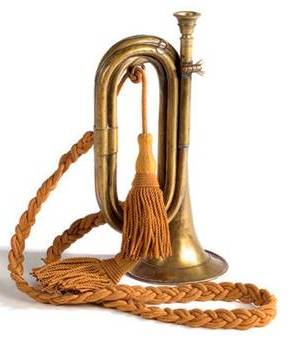 The American Taps
The American Taps
Brigadier General Daniel Butterfield of the Army of the Potomac, which was the major Union army in the Eastern Theatre, commissioned Army bugler, Oliver Norton, to compose a memorable sequence that would signal "lights out" to the entire camp. Norton based it on an older bugle call entitled the Scottish Tattoo. He first sounded the call one evening in July of 1862 and the armies on both sides heard the tune and began playing it.
An artillery officer was so moved by Taps, he ordered it to be played at one of his soldier’s funeral. In 1891, Taps became a great American tradition and was sounded at the end of the day and at the conclusion of American military burials. It is still played at sunset in American military installations around the world.
While the origin of Taps is well documented, a number of myths of how the tune came to be still persist. One tells the story of a Union officer who, after a battle, discovered that the body of a fallen Confederate was actually his own son - a musician in peacetime. When denied permission to bury the boy with full honours, the Union officer held a small impromptu private ceremony. He asked a company bugler to perform a call using the musical notes scribbled on a scrap of paper in his dead son’s pocket - presumably a melody the boy was working on. The tune was Taps. While it’s certainly a moving story, it is not true.
The Last Post
Long before the American buglers were sounding Taps, the British army had come up with its own ceremonial tune. The Last Post is used throughout the Commonwealth at Anzac Day and Remembrance Day ceremonies and military funerals. The Last Post also began as a bugle call marking the end of a day.
During the 18th and 19th centuries, the call was sounded out, phrase by phrase, at dusk while the camp’s duty officer toured the surrounding sentry post. For each stop along the inspection route, more of the tune was sounded to announce his progress. As the officer finished his nightly rounds, the final notes were sounded signalling to the entire company that it was time to sleep. Interestingly, both the Last Post and Taps share a common lineage. Each was derived from a Dutch call from the 1600s called doe den tap toe (“turn off the tap”).
During the 17th and 18th centuries, many English troops were stationed in The Netherlands, so it is possible they adopted a variation of the tap toe. Historians believe tap toe influenced both the Last Post and its forerunner: the Scottish Tattoo. This term also came from the early 17th century Dutch, the signal sounded by drummers or trumpeters to instruct innkeepers near military garrisons to stop serving beer and for soldiers to return to their barracks for the night. Drummers from the garrison were sent out into the towns at 2130 hrs each evening to inform the soldiers that it was time to return to barracks for the night. The drummers continued to play until the curfew at 2200 hrs. Tattoo, earlier taptoo, is an alteration of tap toe which has the same meaning.
Over the years, the Tattoo became more of a show and often included the playing of the First Post at 2130 hrs and the Last Post at 2200 hrs. Bands and displays were included and shows were often conducted by floodlight or searchlight. Tattoos were commonplace in the late 19th century with most military and garrison towns putting on some kind of show or entertainment during the summer months. Between the First World War and the Second World War, elaborate Tattoos were held in many towns, with the largest in Aldershot, England.
Neither the Last Post nor tap toe signal, is to be confused with the US bugle call Taps, which has a similar function but different tune.
Wartime Use
In addition to its normal garrison use, The Last Post call had another function at the close of a day of battle. It signalled to those who were still out and wounded or separated that the fighting was finished, and to follow the sound of the call to find safety and rest. Its use in Anzac and Remembrance Day ceremonies in Commonwealth Nations has two generally unexpressed purposes: the first is an implied summoning of the spirits of the Fallen to the cenotaph, the second is to symbolically end the day, so that the period of silence before the Reveille (sounded on the actual commemoration day) or Rouse (if sounded on a different day) is sounded becomes, in effect, a ritualised night vigil.
The Last Post was used by British forces in North America in colonial times, but its function was taken over in the United States by Taps, which as mentioned has been used by the United States Army since 1862.
Despite often being referred to by the name Reveille, the Rouse is actually a separate tune from Reveille. In camp, the Rouse was traditionally played following Reveille, which was a bugle call sounded in the morning to wake soldiers up. The Rouse would be sounded to call soldiers to begin duties.
Memorial Usage
During the 19th century, The Last Post was also carried to the various countries of the British Empire. In all these countries it has been incorporated into military funerals, where it is played as a final farewell, symbolising the fact that the duty of the dead soldier is over and that he can rest in peace.
The Last Post is used in public ceremonies commemorating the war dead, particularly on Remembrance Day in the Commonwealth. In Australia and New Zealand, it is also sounded on Anzac Day usually before the one minute silence, which concludes with the Reveille.
When the Last Post is sounded during services such as Anzac Day, it is required of all current serving military members to salute for the duration of the call. During services organised by the Royal British Legion, the recommendation is that no salute is given by either officers or troops during the Last Post and Silence. The recommendation is that all troops will have removed head dress, as in church service prayer, have heads bowed, weapons inverted, with flags and standards lowered.
After the one minute’s silence, flags are raised from half-mast to the masthead as the Reveille is sounded. Today, Rouse is associated with the Last Post at all military funerals, and at services of dedication and remembrance.
Last Post has been sounded every night at the Menin Gate in Ypres to commemorate the British & Allied soldiers including Australians, who fought and died there during the First World War. The tradition began in the 1920s but was interrupted for four years during the Nazi occupation of Belgium in World War Two. As soon as the area surrounding the Menin Gate was cleared of German defenders in the fall of 1944, the town’s folk immediately resumed the evening ritual - even though much of the surrounding area was still in enemy hands.
The Reveille is a bright, cheerful call to rouse soldiers from their slumber, ready for duty; it has sometmies been used to conclude funeral services and remembrance services. It symbolises an awakening in a better world for the dead, and also rouses the living back to duty, now their respects have been paid to the memory of their comrades. The Rouse is a shorter bugle call that was also used to call soldiers to their duties; being short, the Rouse is the call most commonly used in conjunction with the Last Post at remembrance services. The exception is the Dawn Service, when the Reveille is sounded. The Rouse is often mistakenly referred to as Reveille.
![]()


What Started World War I?
by Ben Hirsh
(Past President & Life Member)
The most common explanation for the start of what was described as “The Great War” or “The War to end all Wars” is the assassination of Archduke Franz Ferdinand, heir to the throne of the Austro-Hungarian Empire, on 28 June, 1914 in Sarajevo, Bosnia-Herzogovina.
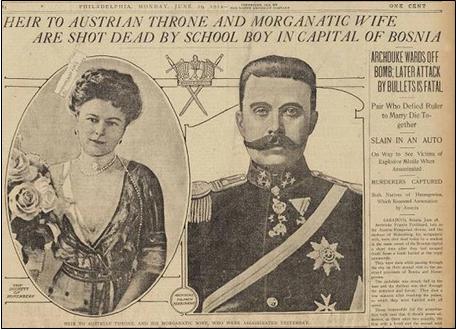 Austria-Hungary annexed this province after the first Balkan War, creating many problems that sparked political unrest in that state. The harsh treatment of the Serbians in that area by the new rulers had created a lot of dissent and a society called The Black Hand, planned and carried out the assassination of the Archduke and his wife Sophie. The political ramifications which followed and ultimately led to the involvement of millions of men under arms by the belligerents, cost unimaginable billions in any currency; the end of empires, the dispersion of millions of people from their homelands and the creation of new independent countries. From 28 June until hostilities broke out, a lot of failed diplomatic activities have become evident, in the light of information available to us via the electronic media. Austria-Hungary demanded concessions from Serbia which were seen as the end of its independence; Germany was an ally of Austria and the Ottoman Empire (Turkey) was also a dominating factor and sided with the former. Russia had a treaty to protect its little cousin Serbia and put its army on alert. Britain, as a prominent European power, tried to mediate in the dispute - without success.
Austria-Hungary annexed this province after the first Balkan War, creating many problems that sparked political unrest in that state. The harsh treatment of the Serbians in that area by the new rulers had created a lot of dissent and a society called The Black Hand, planned and carried out the assassination of the Archduke and his wife Sophie. The political ramifications which followed and ultimately led to the involvement of millions of men under arms by the belligerents, cost unimaginable billions in any currency; the end of empires, the dispersion of millions of people from their homelands and the creation of new independent countries. From 28 June until hostilities broke out, a lot of failed diplomatic activities have become evident, in the light of information available to us via the electronic media. Austria-Hungary demanded concessions from Serbia which were seen as the end of its independence; Germany was an ally of Austria and the Ottoman Empire (Turkey) was also a dominating factor and sided with the former. Russia had a treaty to protect its little cousin Serbia and put its army on alert. Britain, as a prominent European power, tried to mediate in the dispute - without success.
Britain had an alliance with France and promised to defend Belgium, should there be hostilities against her. By the end of July all diplomatic approaches for a peaceful solution had gone unheeded. On 28 July 1914, Austro-Hungarian troops attacked Serbian positions. Russia, coming to its rescue, found itself under attack from Austria and Germany on several fronts. Belgium came under attack and German troops crossed the French borders. Britain declared war on Austria-Hungary and Germany and found itself at Mons, Belgium. That campaign lasted from 5 August to 22 November. At the end of 1914, the Ottoman Empire declared war on the Allies. This marriage, together with Bulgaria, became known as the Central Powers. Eventually the Allies grew in number, with Italy entering the war in 1915, joined by Romania. Montenegro was in the fighting from the very beginning. The neutral countries in Europe were Denmark, Sweden, Norway, Spain, Switzerland and the Netherlands. Portugal joined the Allies in 1917 as did Cuba, Brazil, Panama, Greece, China, Siam and, in April 1917, The United States of America - having followed a state of neutrality despite attacks on her ships at sea; the most tragic loss was the LUSITANIA as early as May 1915.
It has been estimated that some 65 million men were in uniform from the start in 1914 to finish in November 1918, with the Allies having over 42 million and the Central Powers close to 23 million men under arms. The casualty statistics bear witness to the tragic losses of life on both sides: The Allies lost 5.1 million killed and 12.8 million wounded; whilst the Central Powers lost 8.5 million killed and 8.38 million wounded. One should take into account the Spanish Flu epidemic which took its toll after the war.
Australia’s enlistments for the war stand at 416,809 with over 330,000 on active service. Our losses were about 61, 720, died and 166,800 wounded.
We should also pay tribute to the 2139 nurses who served overseas plus another 130 nurses with the British Imperial Nursing Services and 423 nurses who enlisted but stayed in Australia to look after the sick and wounded.
References:
National Archives of Australia
The Official History of Australia in WW1 (CEW Bean)
WW1 Casualty and Death Tables:
www.pbs.org/greatwar/resources/casdeath_pop html
Australian recruitment statistics for World War I:
vroom.naa.gov.au/records/?ID=19590
Various Australian Battalion Histories 1914-1918
Notes from research carried out over the past 40 years
![]()


Should We Put Our Hands Over Our Hearts? No!
by Judy Landau
(Past President & Life Member)
Why do veterans put their hands over their hearts at the Obelisk or after laying a wreath? The simple answer is that they don’t. What the veterans are actually doing, is the Veteran’s Salute to their Fallen Comrades, by covering their medals with their hand. Even Victoria Cross winners cover their medals, because no matter how brave a serviceman or woman has been, the one who made the supreme sacrifice gave their all. There is nothing higher than that.
So how come you see so many of the general public putting their hands over their hearts after laying a wreath or doing something that they perceive to be ceremonial? They believe they are doing the right thing by copying what they see veterans (or currently serving personnel in civilian dress with medals on) doing.
The origin of the Veteran’s Salute began at the unveiling of the Whitehall Cenotaph in London on Remembrance Day 1920. The funeral procession for the Unknown Soldier halted at the new Cenotaph as part of the dedication service, then continued on to Westminster Abbey for interment. The ceremony was to conclude with a march past and the Regimental Sergeant Major was confronted with a gathering all wearing rows of medals, many who had the Victoria Cross and many high ranking military personnel. It was decided that everyone would march past and salute the Cenotaph by placing their hand over their medals, signifying that:
No matter what honours we may have been awarded, they are nothing compared with the honour due to those who paid the supreme sacrifice.
Americans do it differently. Everyone puts their hand over their heart whether it be for saying the Pledge, wreath laying, saluting their flag, playing their National Anthem or sounding Taps.
A few years ago, congress passed a bill which allows prior service personnel who are wearing civilian clothes, the option of putting their hand over their heart or a military salute when the Colours pass and during the playing of the National Anthem. This is permitted both inside and outdoors. They have other protocols about facing the flag, the same as we do.
Their procedures are a topic on its own.
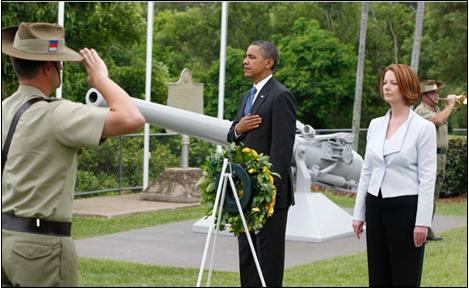 The image (left) shows some of the different protocols when Last Post is sounded at an Australian Service.
The image (left) shows some of the different protocols when Last Post is sounded at an Australian Service.
If you find yourself at a Commemoration Service outside of Australia, it is usual to follow the Australian traditions unless it is known that to do so would cause offence.
We also need to be sensitive to traditions different from Jewish tradition. An example of this in our own culture, is that our men should not wear a hat that is not part of their uniform, to a non-Jewish Service. It is a mark of disrespect to do so. It is considered especially poor form to wear a baseball type cap. It is easy to plan ahead and wear a kippah so that hats may be removed.
If you now realise that you have made mistakes in the past, at least you did your best to honour the sacrifice of our Fallen and are now aware of correct protocol.
![]()


CAPT Sir Daniel Sidney Aarons Kt OBE MC & Bar
by Ben Hirsh
(Past President & Life Member)
Daniel Sidney Aarons served his country in war and peace. As an officer, he commanded troops on the Western Front in France and Belgium - receiving two decorations for gallantry under heavy enemy fire. In peace, he was involved with the Vacuum (Mobil) Oil Company in Fremantle, Western Australia and Melbourne.
His civic duties took him to the chair of president of both Sydney Legacy and the Reform Association. He was also a respected member of the Liberal Party in Sydney holding several high positions.
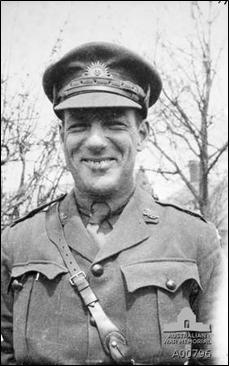 Daniel Aarons was born in the Victorian country town of Donald on 1 August 1885 to Solomon and Annie Aarons. He was educated at North Broken Hill Public School, NSW.
Daniel Aarons was born in the Victorian country town of Donald on 1 August 1885 to Solomon and Annie Aarons. He was educated at North Broken Hill Public School, NSW.
He found employment with the Vacuum Oil Company in Western Australia and was good with his managerial skills. When war was declared in August 1914, Daniel Aarons was very keen to serve his country with thousands of other young men who joined up.
On 27 February 1915, he enlisted as a Private in the 16th Battalion in WA and was posted to 2nd Depot Bn and later to the 25th Depot Bn, being promoted to SGT on 8 October. He was granted a commission as 2LT on enlistment in the AIF on 25 October 1915. He stood 5’ 10¼” tall (1.78 metres) and weighed 175lbs (79.5kgs) and fit for active service. The 16th Bn trained at Black Boy Camp and achieved fitness and skill. He embarked at Fremantle on board HMAT A38, Ulysses with the 15th Reinforcements of the 16th Bn AIF on 1 April 1916. (In that group (25 Reinforcement) was Jewish Digger 4737 PTE Julius Myer Rosenberg, who was decorated with the Military Medal for bravery at Bullecourt, the following year.)
The troopship arrived in Egypt on 29 April and the 16th Bn joined other Australian units for training, at Tel-el-Kebir. There was a lot of activity as the Turks were on the other side of the Suez Canal and it had to be defended from attacks to ensure the free passage of troops and supplies. On 1 June, the battalion embarked on HMT Canada for France and landed in Marseille on 9 June. The French were very pleased to see the Australian troops who came to defend their country and expel the Germans. The 16th, 13th and 14th Bns, made up the 4th Brigade of the 2nd Division. There were many actions and casualties suffered by all units in the fighting at Pozieres and Mouquet Farm, with the enemy using artillery and machine guns which were answered by the Australians. Having been promoted to LT on 9 September 1916 he was again promoted, to CAPT on 11 July 1917. Sadly on this day, his brother 2868 PTE John Fullerton Aarons, of the same battalion, died of wounds received in action in Belgium. He is buried in the Trois Arbres Cemetery, Steenwerck.
On 15 April 1917, then LT Aarons was recommended for the award of the Military Cross. The citation is very lengthy and is signed by LTCOL (later BRIGGEN) E Drake-Brockman CB CMG DSO, who commanded the 16th Bn at that time; it reads:
“This officer is brought under notice for the very valuable work done by him during the operations on the HINDENBURG Line in front of HEINCOURT on the morning of 11 April 1917.
He went over with the first wave in the Infantry Charge made against that line unsupported by an Artillery barrage or the assistance of “Tanks” which had been expected. With great dash he led his men across unbroken enemy wire and into the trenches. By this time his Company Commander had been killed. He at once assumed command of his Company and at once reorganised it. He also assisted in organising and consolidating the whole of the positions won. He organised and led bombing attacks and set a splendid example of courage and devotion to duty to all ranks. When the situation began to be desperate on account of lack of ammunition and bombs and to the failure of proper Artillery support (after consultation with the few remaining Officers), he decided to attempt to cross “No Man’s Land” to bring back reliable information to Headquarters. He succeeded in this task even though nine out of every ten of those who had previously attempted it had been shot dead immediately they had showed over the parapets. The information he brought back was invaluable and cleared up what was up to then a very uncertain position and so enabled proper Artillery and Machine Gun fire to assist our troops when they subsequently had to retire. He is very strongly recommended for high distinction.”
This recommendation for a decoration resulted in the award of the Military Cross. Announced in the London Gazette 18 June 1917 and the Commonwealth of Australia Gazette No 169 of 4 October 1917.
CAPT Aarons was decorated with the Military Cross at Buckingham Palace, London.
With the 16th Battalion moved to Belgium, in a fierce action near Hebuterne, CAPT Aarons sustained multiple wounds in both legs, right arm and back on the 21 October 1917 and remained in hospital in England until pronounced fit in December, when he rejoined his battalion in the field. Whilst the 16th Battalion was part of the British 37th Division (Fourth Army Corps) he was again singled out for acts of gallantry and leadership and recommended for the award of the DSO (Distinguished Service Order). This recommendation, once again shows CAPT Aarons’ skills and qualities of leadership - under the most difficult conditions.
“This Officer is again brought to notice for his gallantry and power of leadership in action. On the night of the 27/28 March 1918 near Hebuterne he handled his Company with great skill; in assisting in the operation which succeeded in outflanking the enemy, and manoeuvring him out of a strongly held position. On the morning of the 1st April 1918 during the attack delivered by us on the enemy positions near Hebuterne he again displayed great skill and resourcefulness in the handling of his Company. Prior to the commencement of the attack he displayed great courage in the personal reconnaissance of the enemy position which he carried out in conjunction with Captain C Ahearn MC, and the success of the attack subsequently made was in a measure due to the timely support and assistance given by him on the left flank of the main attack. Again on the 5th April 1918 when the enemy delivered a very determined counter attack against our positions he showed a very fine example of courage and devotion to duty in moving about amongst his men, and encouraging them to their highest endeavour, despite the very heavy bombardment. The number of casualties inflicted on the enemy on this occasion was in great measure due to his excellent work. Throughout the whole of the operations referred to above, his bravery and powers of leadership were of a very high order. He is strongly recommended for high distinction.”
The recommendation for a DSO was not heeded and CAPT Aarons received a Bar to his Military Cross - indicating a second award.
This award was announced in the London Gazette of 16 September 1918 and the Commonwealth of Australia Gazette No 15 of 4 February 1919.
With hostilities over and the armistice of 11 November 1918, CAPT Aarons still remained in service and after his services were no longer required in England, sailed for the USA on the Olympic - staying for some time. He boarded the Sonoma in San Francisco on 13 January 1920, landing in Sydney on 3 February. From there he travelled by train with the Great Western Railway to Perth. On 3 April 1920 his appointment in the AIF was terminated.
Daniel Sidney Aarons was reemployed by the Vacuum Oil Company but he was not content with just holding a managerial position. In 1925 he married Jessie Stronach. For the next five decades he was involved in numerous civic organisations and remained fit and healthy. He had been a keen rower with the Fremantle Rowing Club before he joined the AIF. As a member of the Liberal Party of NSW, he was Chairman of its Finance Committee 1960-1965; Deputy Chairman 1966-1970 and its Treasurer, 1969-1974. In the Queen’s Birthday Honours List of 1966, Daniel Aarons was made an Officer of the Order of the British Empire (OBE) for public service and on 13 June 1970, he was created a Knight Bachelor and dubbed Sir Daniel Sidney Aarons at Government House, Canberra on 23 October “In recognition as Treasurer of the Liberal Party of NSW.”
Other involvements which made him famous in Australia were:
- President, Sydney Legacy 1946-1947 and member of its Federal Council since 1948
- President, Civil Reform Association 1962-1964
- Positions he held in the Liberal Party, mentioned above.
- Member of the Australian Club
- Recreational activities included bowls.
Sir Daniel Sidney Aarons, Kt OBE MC & Bar died in Sydney on 23 June 1983, just short of his 98th birthday.
References:
National Archives of Australia - WW1 service details
AIF Website for additional notes
AWM Embarkation Rolls 1914-1918
Australian War Memorial Honours and Awards
It’s an Honour website
The Old Sixteenth - being a Record of the 16th Battalion AIF during the Great War 1914-1918. By C Longmore (1929) Reprint obtained from John Burridge, WA
The Imperial Society of Knight Bachelor “Knights Bachelor 1965-1973”
Notable Australians -The Pictorial Who’s Who first edition 1978
Photo from Australian War Memorial website
Another Jewish officer, CAPT (Dr) Charles Herbert Leedman, Australian Army Medical Corps, 1891-1972, received the Military Cross for saving wounded soldiers brought in to his Regimental Aid Post close to the front in 1917; and Bar to the MC in 1918 for continuing in this capacity.
![]()
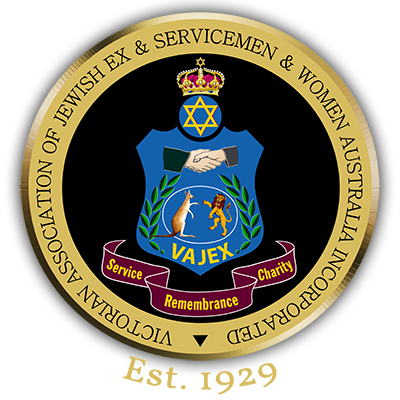
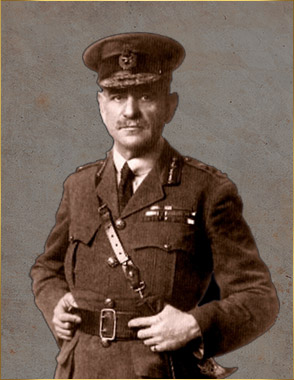 John Monash (Monasch) born
in Melbourne, Australia on 27 June 1865, the son of
German Polish Jewish migrants, can be researched in any
military history encyclopaedia or in fact by just
‘Googling’ his name on the internet. His history
and list of achievements are long and far too many to detail
in this brief summary. However, might I say that reading his
history is well worth the effort and I can assure you that
his deeds will amaze you. I have found that the deeds are
better labelled on more than one man and in more than one
lifetime.
John Monash (Monasch) born
in Melbourne, Australia on 27 June 1865, the son of
German Polish Jewish migrants, can be researched in any
military history encyclopaedia or in fact by just
‘Googling’ his name on the internet. His history
and list of achievements are long and far too many to detail
in this brief summary. However, might I say that reading his
history is well worth the effort and I can assure you that
his deeds will amaze you. I have found that the deeds are
better labelled on more than one man and in more than one
lifetime.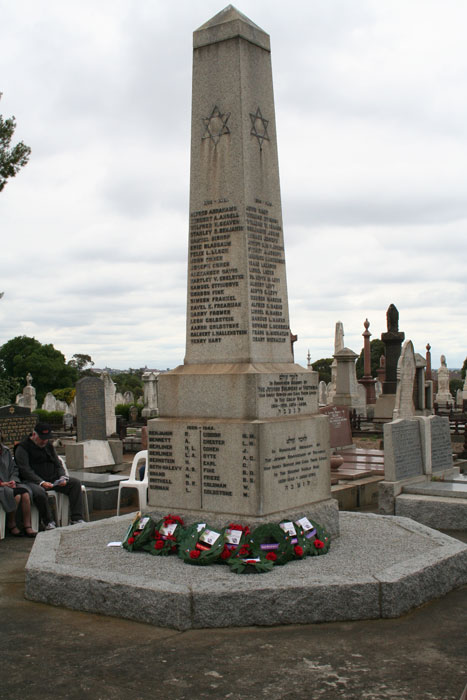 An
announcement was made in the weeks leading up to the
Centenary of ANZAC by Judy Landau, President VAJEX Aust.
She stated that it gave her great delight to announce
that VAJEX Aust (Victorian Association of Jewish Ex
& Servicemen & Women Australia Inc) has
successfully raised the required funds to build a new
Victorian Jewish Memorial after the style of the
historic Memorial located in the Jewish section of the
Melbourne General Cemetery. After an extensive two year
process, Judy has single-handedly sought letters of
support, raised the funds, and obtained approval from
the City of Port Phillip.
An
announcement was made in the weeks leading up to the
Centenary of ANZAC by Judy Landau, President VAJEX Aust.
She stated that it gave her great delight to announce
that VAJEX Aust (Victorian Association of Jewish Ex
& Servicemen & Women Australia Inc) has
successfully raised the required funds to build a new
Victorian Jewish Memorial after the style of the
historic Memorial located in the Jewish section of the
Melbourne General Cemetery. After an extensive two year
process, Judy has single-handedly sought letters of
support, raised the funds, and obtained approval from
the City of Port Phillip.